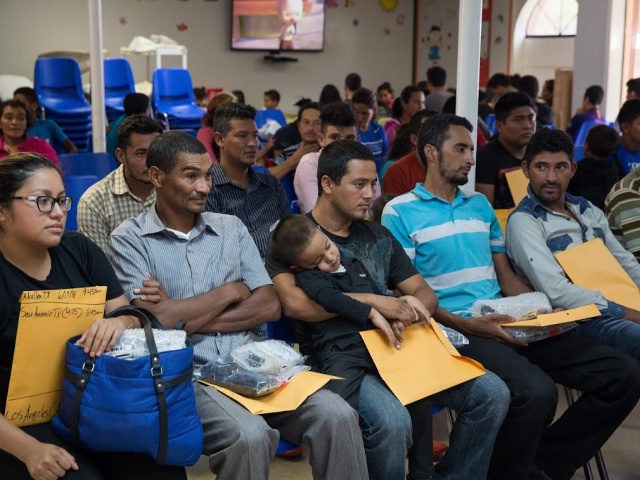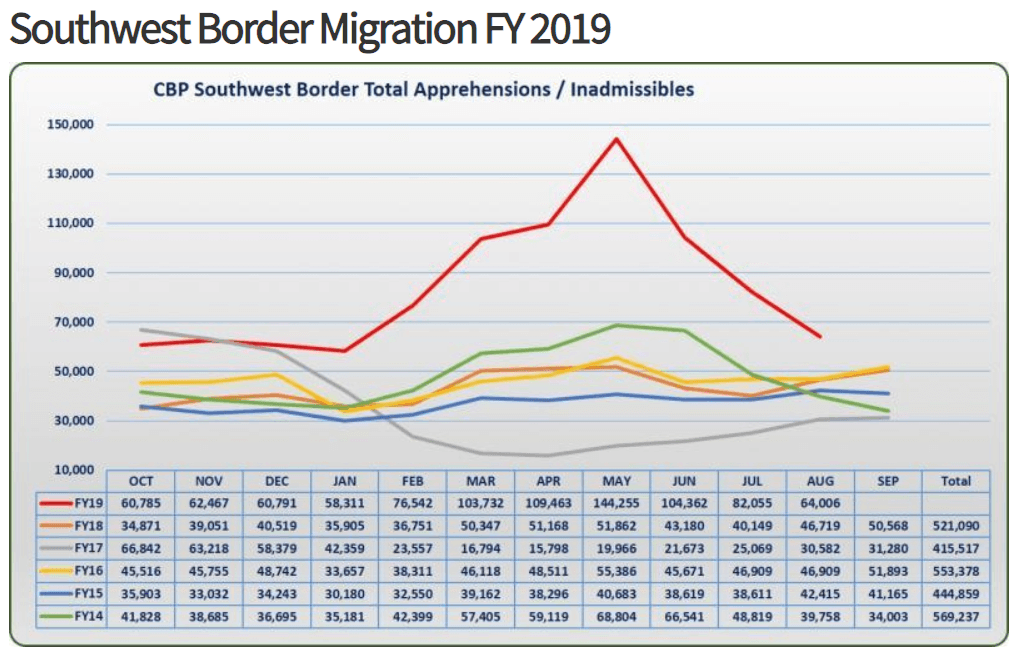President Donald Trump has won the power to shut down the asylum system, complain pro-migration advocates, ending a process which has been exploited by millions of economic migrants to get blue collar jobs in the United States.
The protests came late Wednesday after the U.S. Supreme Court announced it would let Trump’s asylum reforms operate while California judges review their legality.
The court’s decision means Trump’s reforms can operate well into 2020, giving voters a clear way to assess the impact of Trump’s 2020 promises.
“Tonight’s news that the Trump administration will be able to move ahead on what is essentially a complete shutdown of the asylum system at the Southern border is truly awful,” said Todd Schulte, the top lobbyist for a group of wealthy West Coast investors. “It will come with tremendous harm and human cost,” added Schulte, who is the director of FWD.us.
NEW: Tonight's news that the Trump administration will be able to move ahead on what is essentially a complete shutdown of the asylum system at the Southern border is truly awful. It will come with tremendous harm and human cost.
Here is the statement from @FWDus:
— Todd Schulte (@TheToddSchulte) September 12, 2019
His investor group — which reaps large stock market gains whenever Americans’ wages are suppressed — posted a statement:
Tonight’s decision means the Trump Administration will be allowed to essentially terminate the asylum system at the Southern Border. Coupled with the gutting of the refugee program, this is a massive reversal of American leadership to protect the most vulnerable people fleeing extreme violence and persecution from around the world, and is part of an awful pursuit to restrict nearly every legal immigration avenue … tonight, the Trump administration has effectively shut the doors of America to those seeking asylum and a better life.
In June, FWD.us campaigned to win drivers’ licenses for illegal migrants in New York, including illegals who could work as drivers for the investors in FWD.us:
New York state is offering drivers' licenses to many illegals, even though it is unpopular because it aids illegal migration and cuts Americans' wages. So let us follow the money all the way to … Mark Zuckerberg's https://t.co/rMcu0vygjZ lobbying group. https://t.co/xywMXTxdSx
— Neil Munro (@NeilMunroDC) June 20, 2019
The court’s decision should help the border agencies shut off the arrival of new migrants, following the arrival of at least 3.3 million migrants from Central American and Mexico since 2014.
That huge population has used asylum loopholes to squeeze through the border, and then lower wages in blue collar workplaces, raise rents in blue collar neighborhoods and pack classrooms in schools used by the children of blue collar Americans.
The total inflow of 3.3 million adult and child migrants — which does not include the adults who sneaked past border agents — is almost equal to the 4 million Americans who are born each year.
The complaint by business leaders was echoed by their progressive allies in the ACLU. “This is just a temporary step, and we’re hopeful we’ll prevail at the end of the day,” said an ACLU tweet. “The lives of thousands of families are at stake.”
“The Supreme Court’s decision to allow the asylum ban to go into effect (for now) is…. just devastating,” said a statement from Rebecca Kirzner, campaign director of the HIAS group which helps migrants settle in the United States. She continued:
Anyone who has passed through another country (ie, anyone but Mexicans) is going to be denied asylum. For some, that will be a death sentence. The cruelty is overwhelming.
The Supreme Court's decision to allow the asylum ban to go into effect (for now) is…. just devastating. Anyone who has passed through another country (ie, anyone but Mexicans) is going to be denied asylum. For some, that will be a death sentence. The cruelty is overwhelming.
— Rebecca Kirzner (@KirzBecka) September 12, 2019
“We’re struggling to find words,” said a tweet from Al Otro Lado, a legal and aid group for migrants. “There are 10K+ asylum seekers stuck in Tijuana … Our hearts are broken + we’re exhausted.”
“The human toll of today’s asylum ban stay will be horrific,” tweeted Omar Jadwat, the director of the ACLU Immigrants’ Rights Project.
The decision was lamented by Supreme Court justices Ruth Bader Ginsburg and Sonia Sotomayor as bad for foreign migrants:
Although this Nation has long kept its doors open to refugees—and although the stakes for asylum seekers could not be higher—the Government implemented its rule without first providing the public notice and inviting the public input generally required by law. After several organizations representing immigrants sued to stop the rule from going into effect, a federal district court found that the organizations were likely to prevail and preliminarily enjoined the rule nationwide.
…
In effect, the rule forbids almost all Central Americans—even unaccompanied children—to apply for asylum in the United States if they enter or seek to enter through the southern border, unless they were first denied asylum in Mexico or another third country.
The court’s decision was applauded by Trump and his deputies, including Ken Cuccinelli, who was appointed by Trump to run the U.S. Citizenship and Immigration Services agency.
BIG United States Supreme Court WIN for the Border on Asylum! https://t.co/9Ka00qK1Ob
— Donald J. Trump (@realDonaldTrump) September 11, 2019
(2/x) @realDonaldTrump’s administration uses every tool in the toolbox to try and solve the crisis at our southern border. @USCIS will commence implementing the asylum rule ASAP.
— USCIS Acting Director Ken Cuccinelli (@USCISCuccinelli) September 11, 2019
The case is East Bay Sanctuary Covenant, et al., Plaintiffs, v. William Barr, et al., Defendants. The case No. 19-cv-04073-JST.
Immigration Numbers:
Each year, roughly four million young Americans join the workforce after graduating from high school or university. This total includes about 800,000 Americans who graduate with skilled degrees in business or health care, engineering or science, software, or statistics.
But the federal government then imports about 1.1 million legal immigrants and refreshes a resident population of about 1.5 million white-collar visa workers — including approximately one million H-1B workers and spouses — and about 500,000 blue-collar visa workers.
The government also prints out more than one million work permits for foreigners, it tolerates about eight million illegal workers, and it does not punish companies for employing the hundreds of thousands of illegal migrants who sneak across the border or overstay their legal visas each year.
This policy of inflating the labor supply boosts economic growth for investors because it transfers wages to investors and ensures that employers do not have to compete for American workers by offering higher wages and better working conditions.
This policy of flooding the market with cheap, foreign, white-collar graduates and blue-collar labor also shifts enormous wealth from young employees towards older investors, even as it also widens wealth gaps, reduces high-tech investment, increases state and local tax burdens, reduces marriage rates, and hurts children’s schools and college educations.
The cheap-labor economic strategy also pushes Americans away from high-tech careers and sidelines millions of marginalized Americans, including many who are now struggling with fentanyl addictions.
The labor policy also moves business investment and wealth from the Heartland to the coastal cities, explodes rents and housing costs, undermines suburbia, shrivels real estate values in the Midwest, and rewards investors for creating low-tech, labor-intensive workplaces.
Cornell study shows that bad economic policy hurts women's (rational) hopes of marrying higher-income men. So we should see feminists celebrating wage raises in Trump's economy, right? https://t.co/lfYW9ycxDM
— Neil Munro (@NeilMunroDC) September 6, 2019


COMMENTS
Please let us know if you're having issues with commenting.